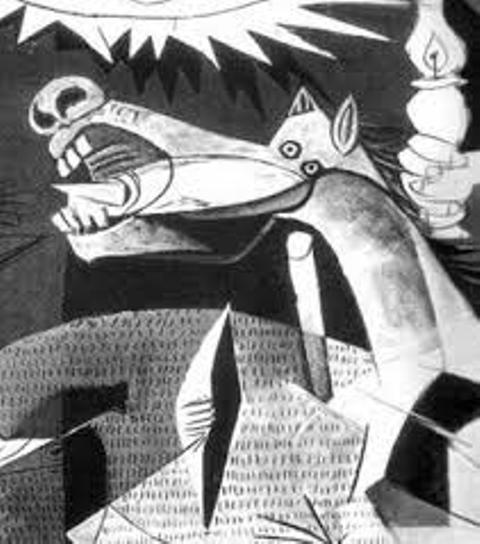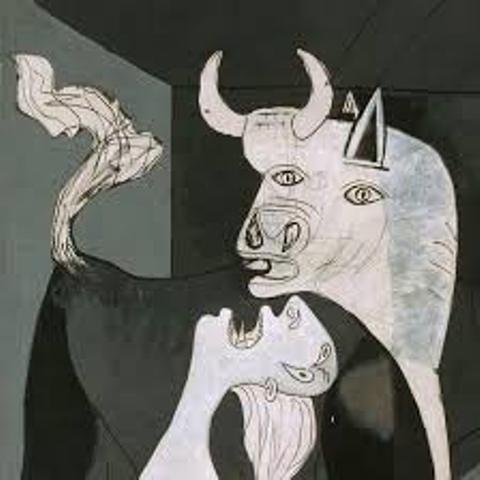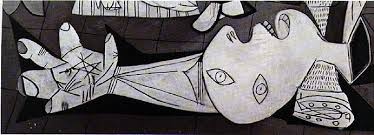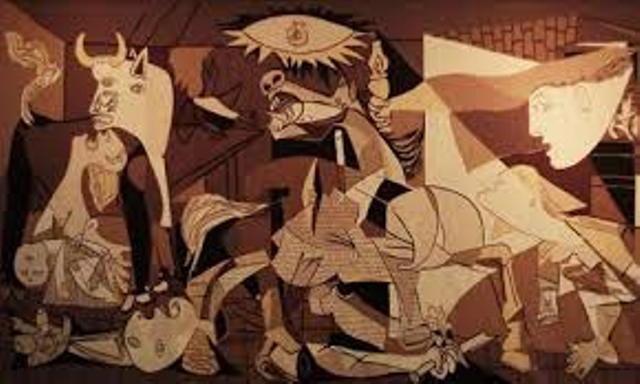Picasso’s Guernica: 80 Years Later

80 years later the images in Guernica are still being debated; even though Pablo Picasso simply stated, “The horse is a horse and the bull is a bull.” (Arbeiter, “15 Fascinating Facts About Picasso’s Guernica”) However, Picasso declared the inspiration for the painting was the aftermath of the 1937 attack of the Spanish town Guernica. On market day April 26, 1937, the citizens of Guernica gathered for their customary shopping and socializing; unfortunately, German war planes descended upon the town. The Nazis bombed Guernica and killed 1600 people; fires burned for three days and destroyed the town. Picasso captured the “la douleur et la mort” or “pain and death” of the aftermath. Yet, Picasso maintained his place that he did not assign meaning to the individual images. Nonetheless, this large-scale monochromatic painting encourages the inner critic to react, deconstruct, and create their own dialogue. Some of the usual suspects up for debate are the horse, the bull, the women, and the solider.
The Horse

The central focus of Guernica is the wailing horse; the mortally wounded animal reverberates with torture and horror. This dagger tongue horse is a nod to the horses of the Apocalypse, according to Dora Maar. Dora Maar documented the process of Guernica with her photographs. (Richardson, “A Different Guernica”) Some critics look at the terrorized horse as the people of Guernica; while others believe it represents the Republicans against the Fascist bull.(Robinson, “Picasso, Guernica) Also, the image shows animals are casualties of war.
The Bull

Ms. Maar believed, “The bull along with the bird are sacrificial victims.” (Richardson) Clearly, Guernica illustrates the opposing reactions to the bombing between the bull and the horse. The bull’s gaze is devoid of empathy; Picasso has remarked that “brutality and darkness” rein. Another point-of view believes the bull embodies Fascism and represents Francisco Franco the Spanish Dictator. (Robinson) (Pablopicasso.org) Furthermore, Picasso used images of both bulls and Minotaur’s in earlier works and critics have said these images are the artist’s ego. (pablopicasso.org) (BBC News, “Piecing together Guernica”)
Pietà

The dichotomy of life and death is revealed in the image of the inconsolable mother and lifeless child. Reference to this image is akin to Michelangelo’s Pieta; additionally, the image of Mother and Child is a staple used in the media to convey the effects of war. (BBC News) Notice the positioning between the bull and other characters; the grieving mother and the two other women facing the bull in distress, the mortally wounded horse, and the dying solider. They, alone, give cause for their own life and death story.
The Women and Solider
Muse, fate, grace, mourners, liberators; these are different types of feminine gender roles found in Guernica. (BBC News) Conchita, Picasso’s sister whom he lost to an illness, is the woman in the painting that is baring forth the light. Dora Maar, self-proclaimed that she was the inspiration for two of the women; the woman in the foreground and the other woman to the right. (Richardson) Entangled amid the agonizing women a solider is found on the floor broken and torn; yet, still holding his shattered sword, a direct causality of war.

The symbolism in Guernica has many stories; some seem clear while a few contradict each other. Picasso advised the viewer to not read too much into the images.
If you give a meaning to certain things in my paintings it may be very true, but it is not my idea to give this meaning. What ideas and conclusions you have got I obtained too, but instinctively, unconsciously, I make the painting for the painting. I paint the objects for what they are.- Pablo Picasso
The quote from author John Steinbeck is like Picasso’s statement about art.
A man who tells secrets or stories must think of who is hearing or reading, for a story has as many versions as it has readers. Everyone takes what he wants or can from it and thus changes it to his measure. Some pick out parts and reject the rest, some strain the story through their mesh of prejudice, some paint it with their own delight. A story must have some points of contact with the reader to make him feel at home in it. Only then can he accept wonders. -John Steinbeck

Conclusion
Picasso did not assign meaning to the images in Guernica: however, these images inspire the observer to create their own war story with heroes, villains, oppressors and martyrs. Furthermore, a tapestry of Guernica hangs in the United Nations building as an icon for the antithesis of war. Eighty years ago Picasso presented Guernica at the Paris World’s Fair as a tribute to the aftermath of the bombings. Moreover, it is still relevant as a construct to external and internal struggles of war; case in point, Syria, Palestine, Israel, Afghanistan, Iraq, Rwanda, Sudan, Bosnia and the Ukraine. In two more decades Guernica will be 100 years old; the world will still be full of warring spirits and Guernica will continue to remind us of the autocracies of war.
Work Cited
Arbeiter, Michael. 15 Fascinating Facts About Picasso’s Guernica. mentalfloss.com/article/63103/15-fascinating-facts-about-picassos-guernica. Accessed 1 Jun. 2017.
BBC News. Piecing together Guernica. news.bbc.co.uk/2/hi/7986540.stm. Accessed 1 Jun. 2017.
Pablo Picasso Paintings, Quotes, and Biography. www.pablopicasso.org/guernica.jsp. Accessed 1 Jun. 2017.
Richardson, John. The New York Review of Books. A Different Guernica. www.nybooks.com/articles/2016/05/12/a-different-guernica. Accessed 1 Jun. 2017.
Robinson, Lynn. Picasso, Guernica. KhanAcadamey.org. Khanacadamey.org/humanities/art-1010/early-abstration/cubism/a/Picasso-guernica. Accessed 1 Jun. 2017.
Steinbeck, John. The Winter of Our Discontent. Viking Press. 1961, New York.
What do you think? Leave a comment.











I’ll be in Spain later this year, and one of the first items I put on the itinerary was a visit to the Reina Sofia. I have to admit, when we studied Picasso in my middle school art class, I didn’t get it. He’s still not one of my favorite artists, but I absolutely respect his talent, his influence, and his passion. This painting, like the story behind it, is haunting and moving. Picasso’s chaotic style really works here, where I think that being confused, and shocked, and taken aback, and hurt, and even a little disgusted is the POINT.
Lovey to hear you will be in Spain and that the museum is on your itinerary!
Love this art piece. As a Spaniard, the painting means so much to me. Picasso accurately represents the pains and tragedies of the Spanish Civil War with Guernica, but its timeless message applies to all wars.
ikam, thank you for relating and sharing your thoughts as a Spaniard and the tragedies of the Spanish Civil War.
my interests, which have hardened into habit & my work life don’t permit my ambling into the world of art, though it does always have a noticeable effect on me should i come into contact with it. i used to spend hours in the art galleries in manchester while studying there. picasso has given us plenty to work with, the title for a start, if you were to ask the right question & inquire would lead you to some information on the theme. it is not the artists task to tell you everything, how very dull art would be. it is the same with a poem.
gaze, I agree, it is not the artist’s job to tell you everything. I believe the artist is a conduit of the inspiration that flows through to the beholder.
Great analysis of Picasso’s work and sensitivity to the artist’s intention. I visited the Picasso museum in Paris a long time ago and gained an appreciation for the first time. Hope to hear more from you on the artistic pieces. I always learn so much.
Munjeera, you are such a lovey light, I learn so much from you as well. Looking forward to your next piece. Cheers!
I was looking forward to seeing this article go live. A great piece of work and a fascinating analysis.
Amyus, thank you for your review and edits, glad you liked the finish piece.
Your state of knowledge is by far outdated – read my short book: Guernica oder Picassos “Abscheu vor der militärischen Kaste” (Freiburg/Br: Rombach, 2017)
Mr. Merz, so honored you had time to read my article. In regards to your book, I would love for you to send my an autographed copy to read and review.
Please send your address to j.merz@uni-muenster, and you will get a copy of my book before long! Kind regards, Jörg Merz
Yum, absolutely, I will connect with you right now, YAY!!!
I just received your fabulous book, and can’t wait to explore your information. It is very well put together. Thank you!!!!!!!!
For anyone wanting to explore more information on Picasso I would suggest Professor Merz’s publication, “Abscheu vor der militärischen Kaste” (Freiburg/Br: Rombach, 2017)!!
There are many reasons Guernica still resonates so long after most people forgot the specific atrocity that inspired the work. I’ve always been struck by the prominence of the animals, which is even more pronounced by the massive scale of the painting. To me, the image is made indelible by the shared horror shared by all living things facing death.
Kimbra, I appreciate your review, you captured all the important elements. Thank you.
Lovely article. Art is so much more than some can see. Thank you for sharing it with us.
Marlin, you are so welcome. I really enjoyed researching the material for this piece.
I studied this painting and Picasso during my Art History A-Level. It’s also in the background of one of the scenes in “Children of Men”.
Lynsey, thanks for letting us know you spotted Guernica in “Children of Men.”
I have been wondering how we as a society will re-bound from this new oppression. I have been waiting for an uprising of artists, of musicians and painters and writers, but mostly all I have heard is …silence.
It’s also my hope that the arts will prove to be tremendously powerful political agents, like we’ve seen throughout history. I wonder if maybe it is still in the early days but I’m definitely making it my priority as a writer to spotlight works of Resistance.
Nice analysis of the artist’s vision toward educating the masses on war atrocities.
Barha, thank you for reading the article and for leaving your insights.
Picasso must have thought of Goya when he decided to do without colour.
Keren, interesting thought with regards to Goya and the lack of color. I feel the use of a monochromatic palette adds more to the intense subject matter, and makes reference to the periodicals. The news reporting at that time was in black and white and if you look closely the images seem to have the feel of newsprint.
Guernica and your telling of its story reminds me of just how creative Picasso was an artist. And not just creative or intellectual but passionate. My first reaction in looking at it again was that Picasso was really the first Abstract Expressionist. That’s probably not true and is not worth pursuing I think. But surely this does show how artistic and abstract liberties can add to the emotional power of art.
Leak, I like your phrase “abstract liberties” it conjurers up many thoughts. I agree there is a great deal of emotional power in this work of art.
The art piece is aimed at warmongers and fascists. It exists to make them ashamed.
Isidro, it raises many feelings and unfortunately, war still exists.
This is an incredible piece of artwork! It speaks of the savagery throughout the ages from the Greeks, the Romans, Napoleon, and present day conquerors while everyday people suffer with their lives at the expense of the desires of leaders and rulers. Picasso is the best!!
Thank you for relating this piece to the past, I appreciate that aspect.
I think his genius was recognized in the longevity of his work and its continuous influence in the world. Ironically, it’s probably its bizarre style that has helped the painting stay relevant. It has been fascinating and studied even today. Guernica depicts numerous figures screaming in terror and writhing in fear, and if anything, the “warped cartoon-like figures” show the warped nature of war and its ability to change us, to challenge us, and to destroy us. Not everyone will agree, but if there are flocks of non-artsy people and scholars that see this mural each year, then I think the message was clear enough.
Al, excellent review, I like “warped-cartoon-like figures” and that this piece can be engaged by art patrons as well as those who do not consider themselves well versed in art.
Thanks for bringing up an important topic. It’s important to remember the healing power of art. It’s important to learn from the past.
Thank you Minter for the kinds words and I like the healing power of art.
It’s interesting how it relates to what was going on at the time of its creation.
Yes, the Spanish Civil War was the inspiration as interpreted by Picasso.
Pleasure to see and read. I did see Guernica in person at MOMA at least once but that was many years ago. It’s nice to be reminded of its power.
I saw the Guernica at the MOMA the first time too but it didn’t mean much then–it was just a big Picasso.
I love MOMA, however, I did not see Guernica, perhaps a trip to Spain!
Eloquently written Venus.
Lai, with grace and gratitude I thank you.
Not one who knows much about Picasso or other artists and their works but these are very important issues raised. Man is just too violent for there to be peace, ever on this earth.
Yes Len, humans are very violent, but we also create beautiful things.
It’s difficult to find educated people on this topic, however, you know what you’re talking about! Thanks.
Fanny, thank you, it is passion driven along with research and it is a privilege to share this information, thanks again.
After having been totally enamored of Picasso for a good 10-20 years I’ve not paid much attention to him in the last 10 or 20, remembering more his public persona than his art.
Fulton, the public persona is amazing for Picasso, I appreciate you revisiting the artist through this article.
This was a fantastic read! I would love to cite this work for a paper I’m writing.
Will, please do use this information for your paper. Message me if you need any additional information!!!
I have been to Guernica where a massive mozaiek of the painting is displayed. I am not that much into art but taking in this massive painting brought me goosebumps, tears in my eyes and a very strong feeling of disgust against what happened that very day in 1936.
Jaqueline, thank you letting us know about the mosaic in Guernica, that is a very interesting fact.
Guernica is a work that seems to increase in relevance over the years.
Pool, this seems true, will see when it hits 100 years.
I thought it was a perfect assessment of this lovely and horrific work of art that moves me to tears every time I see it. I will be thinking of the painting and your piece. Thank you.
Hui, thank you so much, I greatly appreciate your kind words.
Art like this is why I started my own art blog.
Well Gus, do share you art blog, I would like to read some of you articles.
Meaning is a complex notion. What does a given image mean? – is a difficult question to answer. is meaning in the artifact? in the mind of the creator? in the mind of the viewer?
Delan, yes contemplation is a factor with art in all forms. Thank you.
Guernica is one of the most important works of art of the 20th century. It is also a warning of what can happen.
Ragan, yes, Gurenica is a warning, but also as In Herbert pointed out it has been going on for centuries, and I will add that is only the recorded history.
I thought your piece was really interesting and got me thinking about art in a way I hadn’t really thought of before.
Rashad, I am so excited, this is such a compliment, engaging in new thoughts and about art, I am elated. Thank you for sharing!!
Art back in the day had more meaning
What an interesting painting and story behind it!
Initially Picasso started doing an interpretation of the Rape of the Sabine Women – a biblical story which many artists had a version of. This was abandoned when he saw a black and white photo of the bombing of Guernica in the newspaper El Pais. (He did a much later “Rape of the Sabines” at the height of the Cuban Missile Crisis in 1962).
kez, thank you for adding this information, I came upon in while researching. However, I did not put together the Cuban Missile Crisis and the Sabine Women. Thanks again.
It is very power full imagination
Such an interesting and fresh take on these pieces, thank you for all you explanations. I found your article very engaging and extremely educational.
Thank you Julie!
Thank you!
This was really interesting, and had some great analysis on such an iconic piece. Thank you!
I can finally say (having contributed to the Art category) that I can better appreciate your text and the object it covers. I have often heard that when a person has a near death experience that they see a sequence of their entire life flash before them. I can only say of this artwork that Picasso may have been trying to capture that tragic element of life through this montage. A very valiant attempt at seizing the flurry of processes that traverse the human body in that moment.
Delicious observation; I can pan this image with the thoughts you dropped into my mind and follow exactly to what you speak to.
Lovely.
Really enjoyed reading your analysis. To me this painting is similar to what I imagine an allegorical poem of the atrocities of war, and specifically the moment of death from the nature of unrestrained violence in war, conjures in the mind. As is it such a large artwork, I think it’s power comes from taking in all the various aspects of expressions, disjointed contortions and layered states of agony, and seeing them as a complete description of man’s unrelenting inhumanity against mankind.
I greatly enjoyed reading your analysis on Guernica. You would greatly enjoy the Power of Art episode on Picasso and Guernica. In the end, it talks about an incident in February 2003 when the US delegation presented its case to the UN on armed intervention. The tapestry at the press conference was completely covered up because it was a reproduction of Guernica hanging on the wall. I thought this made a great point about the enduring importance of the masterpiece.
Bansari,
Yes, I read about the ‘cover up’ at the UN when I was researching this piece. Thank you for bringing this to the attention of the readers.
I remember first being introduced to this artwork in my senior English class! We were asked to observe it through the lens of history and memory, which was an absolute delight for me as someone who loves visual analysis and art more generally. This is a great breakdown of such a visually arresting piece of work.
I remember seeing this painting years ago. A good piece to help understand how to look at this painting.
Guernica is one of those works that will be debated relentlessly as the icons and symbolism can be interpreted in the contexts of history and art, but maybe Picasso had no underlying intentions – only the artist knows what they want to say. It’s one of those pieces you can look at for hours and read what you think the artist was saying.
We have this piece hanging on the wall above our bed–or a 2,000 piece puzzle actually. Though my eyes have revisited Guernica many times, there is always an eye, gaping mouth or broken figure that holds my gaze a little longer. You can hear the chaos in this piece, and you can gather from it this or that. I guess that’s what makes it art?
Amazing article.
I really like this art piece and also the story behind this painting.
I think that the feminine gender roles in Guernica, and in all of his work, are especially important when examining the way that Picasso treated the women in his life. A book that provides a lot of good insight into Picasso’s relationship with the feminine is “Picasso: My Grandfather” by Marina Picasso, which chronicles the horrible way that Picasso treated the women in his life.
Great article.
This was an interesting topic when I first entered college.